Learning to love the subtle beauty of a winter garden
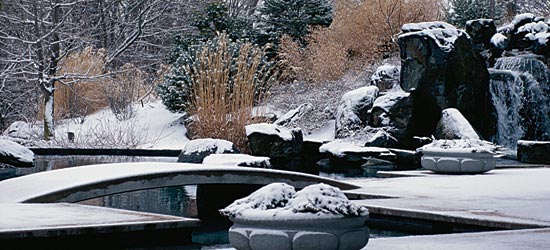 |
Winters in Chicago can be so dreary and gray that looking out the window is almost as joyless as actually venturing out into the biting wind and ankle-deep slush.
One of the best ways to dispel the gloom is to build year-round visual appeal into your garden. Consider how this fantastical St. Charles garden pops in winter. Surrounded by 21 acres of natural landscaping, it is a five-acre wonderland of waterfalls and lagoons, enormous boulders and extensive plantings. In summer, it’s an oasis that beckons the family and friends of homeowners Jon and Melissa Butcher. In winter, says Jon, "we aren’t the type to go outside much, so it becomes this beautiful backdrop we see framed in our windows from inside. It’s composed consciously, like a piece of art in a frame."
The Butchers’ landscape designers, Sara Furlan of Mariani Landscape in Lake Bluff and Hoichi Kurisu, an eminent designer of Japanese-style gardens based in Portland, Oregon, were working on a scale far beyond the reach of most of us-they brought in 1,500 tons of granite, among other things-but many of the elements they incorporated can heighten the winter appeal of any garden.
Everybody Must Get Stone Although they appear to have tumbled across the landscape, propelled by a great natural force, with some coming to rest in the pool and others among the plantings, the boulders in the garden were precisely placed for maximum visual effect. "Stone is very good for your winter garden because it’s not a plant that will die away," Furlan says. "It’s textured, and it’s a permanent object that creates structure, like a fence or a sculpture, but it’s more connected to the earth." The stones in this garden have a rough, monumental look to them, "to reference the house and the big landscape," Furlan says.
In small gardens, a stacked-limestone wall or a ring of bread-loaf-sized stones around a tree can provide a similar effect. Brick works, too: Furlan points out that a plain red-brick path revealed by shoveling away snow has a "surprising effect, some texture and color your eye catches."
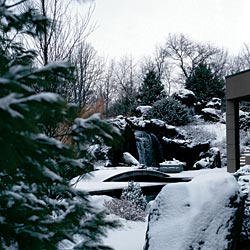 |
| Natural elements like evergreens, stones, water, and of course, snow, combine with unimposing man-made touches, such as this simple footbridge, to create a serene winter scape. |
Fine Lines The simple arched bridge has a subtle grace that makes it noteworthy in summer, but when snow lands on it, "that reinforces its geometry and makes it striking," Furlan says. The subtlety of a white-on-white landscape rarely fails to please the eye in the winter. Nor does its opposite, the stark beauty of fresh-fallen snow outlining dark branches and making even telephone poles look elegant.
The simplicity of the footbridge and the decking provides visual relief from busier sections of the garden. "You don’t need something going on everywhere," Furlan explains. "Having some of those restful spaces is important to the larger picture."
In many yards, the spread of lawn is the primary visual plane. Is it too much? Break it up by placing a garden ornament or large pots filled with evergreen boughs or red dogwood twigs in the middle of the lawn, where a snowy transformation can be enjoyed from strategic spots indoors.
Some of this is serendipitous, of course; you can’t control how snow falls on a footbridge or a tree branch. The point is to notice lines in the garden that grab the spotlight when snow accentuates them. And then: leave it alone! If possible, don’t let kids and pets trample the snow there. Think of it as a temporary sculpture that will disappear soon.
Green, Ever Green Dozens of evergreen trees fill the winter view of the Butchers’ garden-but in summer you’d be less likely to notice them, because there’s so much color and vibrancy all around. "Evergreens play a much stronger role in the winter," Furlan says. "They might just be part of the backdrop in the summer, but in the winter they help form the garden’s personality."
They might be formal, clipped boxwood hedges or shaggier pines and spruces. In the Butchers’ garden, Jon notes, evergreens play off the boulders very well because of their similar sizes and contrasting textures. "The evergreens give the perfect softness to the stone," he says. "When the deciduous plants go away, the evergreens and the stone really get a chance to work together."
Dip Me in the Water Many of water’s most beautiful qualities-its mirrored surface, the soul-nourishing sounds it makes when in motion-become more pronounced in the stillness of winter. Water is a centerpiece of the Butchers’ garden, crashing over seven-ton stones into a chest-deep lagoon punctuated by boulders.
In winter, the lagoon is heated to about 40 degrees, enough above freezing that steam rises off the water on many cold days. "It’s a really spectacular winter effect," Butcher says. Furlan notes that it has its price, however: "You lose a lot of water to evaporation as steam," she says.
Nevertheless, she advocates keeping a small backyard pond heated in winter, both for the ethereal steam it creates and because if the pond has fish, they’ll be more active in heated water. "They’ll be slower than in the summer," she says, "but it can be a wonderful respite on a warm-up day in February to go out there and see them moving around."
Small trickling fountains and other water features also enhance winter interest, attracting wildlife and bringing color and movement to the frozen landscape.
Grass with Class Many perennial plants leave behind lovely souvenirs for winter in the form of rigid stalks and dried flowerheads. But ornamental grasses do the best job of reminding us of their summer presence. Their billowy flowers and foliage change from green into colors that perfectly suit winter’s subtlety.
"Grasses add a beautiful texture and an indigenous feeling-like this is what would have been here if humans hadn’t touched it," Jon Butcher says. Some of them, such as miscanthus and ravenna grass, also have enough height to keep an off-season perennial bed from looking flat as a pancake. "In some places, grasses act as the bones of the garden in the winter," Furlan says.
RESOURCES Landscape Design: Mariani Landscape, 300 Rockland Rd., Lake Bluff, 847-234-2172; marianilandscape.com. Kurisu International, Portland, Oregon, 888-441-5137, kurisu.com.
Grass Menagerie
With hundreds of species of ornamental plants on the market, how can you make sure that your grass-roots efforts succeed? We asked Kathie Hayden, a horticultural specialist at the Chicago Botanic Garden, to recommend a few ornamental grasses that do well in Midwestern winters.
-Sarah Hollenbeck
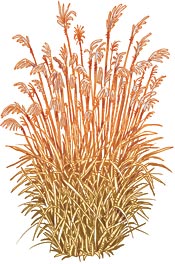 |
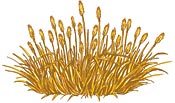 |
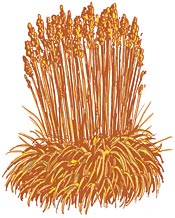 |
|
Graziella Maiden Grass Recommended species: "‘Graziella’ has a strong presence in the garden, a bold personality with a calming demeanor," Hayden says. "Silvery blooms appear from August until frost, and gold foliage adds a bright spot to any winter landscape." |
Purple Fountain Grass Recommended species: "Even though this is considered an annual ornamental grass, its long-lasting blooms, starting in late June or early July and lasting until frost, make it worth having to plant anew each spring. Also, it’s excellent for large container plantings."
|
Ravenna Grass Recommended species: "This is a good ornamental grass for gardeners who are looking for a large background plant. Early frosts sometimes interfere with the large plumes that begin blooming in September or October. It is very hardy in the Chicago area." |
Photography: © Mariani Landscape
Illustrations: John Wiencek



